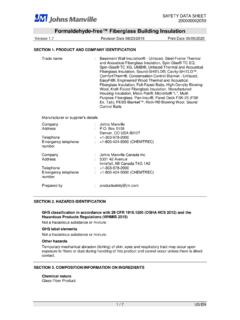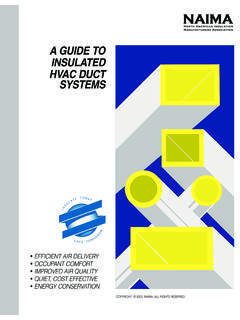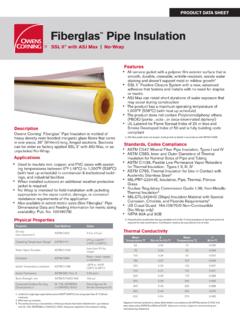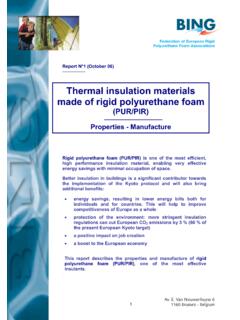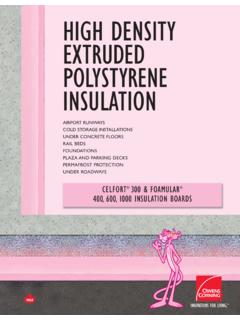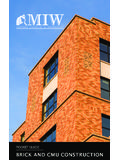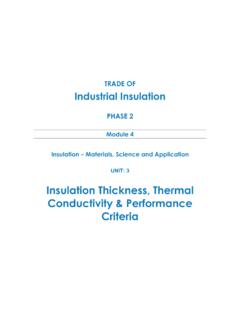Transcription of Technical Requirements Definitions Condensation Q/A
1 HVAC insulation Thermal insulation Technical Requirements Definitions Condensation Q/AHVAC insulation ThermalThermalInsulationHVAC insulation Thermal insulation , in principal, is the resistance to reduce the heat transfer in a considerable amount. cold lines prevents heat loss heating lines prevents heat gainsHVAC Ins. In Buildings;in Winter time Heat Lossesin Summer time Heat GainsThe Resistance03In HVAC;in Heating Lines Heat Lossesin Cooling lines Heat Gainsis Thermal insulation HVAC LinesWarm LinesHeating LinesCold Warm and Heating Lines04 ColdLines+6 CWarm LinesHeating Lines+100 CHVAC Building HVAC Technical insulation05 Circular Surfaces (Pipes) Rectangular Surfaces (Air ducts) Valves and Accessories Technical insulationHVAC insulation Material06 What is a Thermal insulation Material?
2 According to ISO and EN Standards; If >0,065 W/mKBuilding Material If <0,065 W/mKThermal insulation MaterialHVAC Ins. Glasswool(EN 13162) Stonewool(EN 13162) ExtrudedPolistren(XPS) (EN 13164)Thermal insulation Materials07 ExtrudedPolistren(XPS) (EN 13164) Expanded Polistren (EPS) (EN 13163) Polyurathane (PUR) (EN 13165) Phenolic Foam(EN 13166) Cellular Glass(EN 13167)HVAC )Thermal Conductivity Coefficient( )2)Water Vapor Diffusion Resistance Coefficient( ) 3)Fire Classification (DIN 4102, BS 476, EN 13501)4) Corrosion Risk5) Temperature Range( C)6)
3 CellStructureTechnical Requirements086)CellStructure7)Acoustic Performance8)Density (kg/m3)9)Weathering Resistance10)Dimensional Stability11)EasyApplication12)EconomicsN OT: Temperature rangeis not a selection criteria, it defines the usage is the quantatiy of the energy which passes through a m3 of insulating material where there is 1C difference in tempurature between opposite Thermal Conductivity ( )31m1m1mWARMT1 COLDT2 (W/mK)Heat Transferred3 HVAC TM= at mean temperaturet+ tThermal Conductivity ( )tm =tmedium+ tambient2 HVAC Conductivity Coefficiency (MeanTemperatureCThermal Conductivty(W/mK)
4 10 12 1618 20 24 3032 36 4860 ) is the ratio of the resistance to the water vapour diffusion of an insulation material to the resistance of Vapour DiffusionResistanceCoefficient ( )resistance of airHVAC = 1( no resistance to diffusion )9 = ( no diffusion )Water Vapour Diffusion ResistanceCoefficient ( )9 =.
5 Aluminium ( E = )Diffusion tight materialsHVAC Fire Classification DIN 4102 BS 476 BS 476 EN 13501 ThermalAIncombustible materialsA1 That does not contain combustible materialsA2 ThatcontainscombustiblematerialsDIN 4102 Standard15A2 ThatcontainscombustiblematerialsBCombust ible materialsB1 Hardly combustible materialsB2 Normal combustible materialsB3 Easily combustible materialsHVAC 4102 ClassA(Incombustible)ClassB(Combustible) 16 DIN 4102 StandardA1A2B1B2B3 PUR EPS Wood Paper Wood Sand Concrete Brick Glasswool Stonewool Glasswool Stonewool XPS PEHVAC 13501 Standard : GlassWool17A1 Thermal18EN 13501 Standard : FEFBGs3Gd0 ThermalSteel Pipes ; According to DIN 1988 Part 7 Section 5:3 Limit Values4.
6 Corrosion Risk19 Chlor(%0,05)Copper Pipes ; Nitrate ve Ammonia(%0,2)HVAC insulation Temperature( C)Ceramic wool1800 Stonewool750 Cellular Range20 Glasswool250 FEF *170 Melamine Foam150 Phenolic Foam120 Polyurathane110 Polyethylene105 HVAC =1open cell = 6. Cell Structure = closed cell = cellHVAC : Densityis the only specification that can be measured in the :Mechanical ResistanceThe Other Requirements22is the compressive strength at % 10 : Dimensional Stability11: Easy Application12: EconomicsHVAC Thermal insulation Materials are used Question:123inHVAC Applications ?
7 HVAC Ins. Glasswool (GW) Stonewool (SW) Flexible Elastomeric Rubber Foam (NBR)Thermal insulation Materials in HVAC Applications24 Flexible Elastomeric Rubber Foam (NBR) Extruded Polyethylene Foam (XPE) Polyurathane Foam (PUF) Phenolic Foam (PF) Cellular Glass (CG)HVAC :2 Whichthicknessshouldbe used?Whichthicknessshouldbe used?HVAC ProgramFor PipesFor Flat Surfaces Heat loss Heat lossWhich thickness should be used ? Temperature drop Surface temperature Freezing time Minumum insulation thickness preventing Condensation Heat loss Surface temperature Minumum insulation thickness preventing condensationHVAC : Minumum insulation thickness preventing Condensation for Pipes.
8 PARAMETERSA mbient temperature ( Ta C)30 Medium temperature( Tm C)6To Prevent CondensationmTube diameter (mm)114 insulation materialRGFlexGSTR elative Humidity (%)70 RESULTST hermal Conductivity (W/mK) point temperature ( Td C) insulation thickness (mm) dimension13 x 114 HVAC Temperature ( Ta) : 35 CMedium Temperature ( Tm) : 6 CPipe Diameter (inch): 2 Energy SavingRelative Humidity (%): thickness to prevent Condensation : ! insulation Thickness9 mm. 13 mm 25 mm 32 mmEnergy saving due to thickness62%69%78%80%HVAC :3 Howis possibletopreventcondensation?
9 Howis possibletopreventcondensation?HVAC of the CondensationTm = 6 CTs = C = % 65Td = CTa = 30 CR:Flex STSurface temperature >Dew point temperatureNo Condensation !Thickness =9mmTs = C > Td = CTube diameter = mmMinimum insulation thickness = mmHVAC Affecting the Dew Point Ambient Temperature ( Ta= C ) Relative Humidity ( = % ) Medium Temperature (Tm= C ) HVAC is Relative Humidity?HVAC of Condensation Ambient Temperature ( Ta= C ) Relative Humidity ( = % ) medium temperature ( Tm= C ) medium temperature ( Tm= C ) Air flow The heat transfer coefficient ( ) Thermal Conductivity ( ) Water vapour diffusion resistance coefficient ( )HVAC of Affecting the Dew Point Ambient temperature ( T= C ) Ambient temperature ( Ta= C ) Relative Humidity ( = % )
10 HVAC = Heat Transfer Coefficient of the Surface Parameters of is being changed according to the material structureHVAC ) If no thermal insulation is applied, 2) If an nsufficient thermal nsulation thickness is applied, Condensation on the Surface!34 How does Condensation happens3) Sufficient thermal insulation Thermal insulation material with alow valueCondensation within the insulation Material! Thermal insulation material with ahigh valueNoCondensation !HVAC : If no thermal insulation is appliedTs = CTm = 6 C = % 65Td = CTa = 30 CTube Ts = C < Td= CCondensation on the SURFACE !



